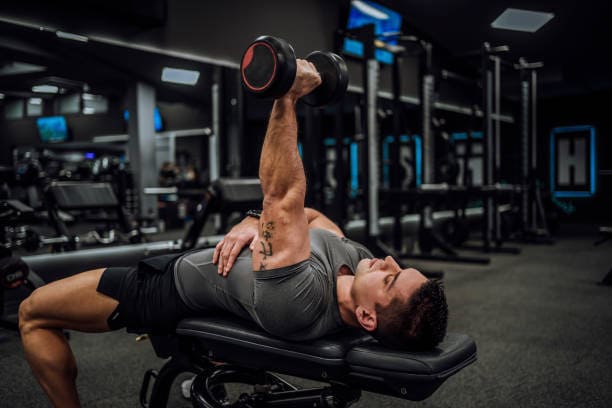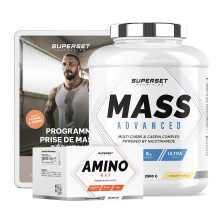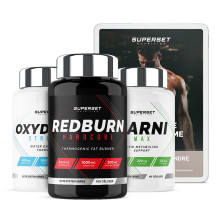How do you set and reach your bodybuilding goals?

Bodybuilding is a lifestyle that requires discipline, determination and, above all, clear goals.
Whether you're looking to gain strength, build muscle mass, improve performance or lose weight, setting clear goals is the key to your success.
In this article, we'll take you through a five-step process to help you define and achieve your bodybuilding goals.
How do you set sporting goals?
Step 1: Evaluate and record your body composition
First of all, I'd advise you to take out your phone or a notebook and note down your basic measurements, so that you can monitor your progress, and adjust your program according to your notes. Do a self-assessment of your physical condition, strengths and weaknesses.
Take note of your current weight, measure the areas of your body (thighs, stomach, arms, etc.), calculate your BMI, your percentage of body fat and write down your training performances (number of kilometers covered, number of repetitions, load lifted, etc.).
This step will enable you to set realistic goals and monitor your progress.
Step 2. Define a clear and simple physical or sporting goal
Now that you've identified your starting point, ask yourself what you want to achieve through sport, and set yourself a simple, global objective.
Your goal should be specific, measurable, achievable, relevant and time-bound (SMART).
For example, you could aim to increase your strength by 20% in the next three months, or lose 5 kilos of body fat by the end of the year.
Step 3. Choose or set up a sports program adapted to your needs
You can create your own sports program based on your objectives, or on Superset Nutrition we offer you an e-book with a detailed plan created by a sports coach for our different packs!
We offer a pdf for every goal, whether you want to gain muscle, build mass, improve performance, lose weight or sculpt your muscles. There's a program for every goal, adapted to your level (Beginner, Advanced, Expert) for men and women.
Select the one that best meets your expectations, based on your current level.
Step 4. Draw up a detailed action plan
Once you've selected your program, draw up a detailed action plan to achieve your goal.
Plan your work outs according to your schedule, draw up an eating plan by calculating the number of calories you need per day (basic metabolism + your daily expenditure) and note down your recovery days.
Make sure you stick to the plan, and stay disciplined even if you're not motivated. Don't hesitate to adjust your schedule if you need to, and always keep to your weekly number of sessions.
Step 5. Monitor your progress regularly
Finally, monitor your progress closely and adjust your action plan accordingly.
Regularly measure your performance, weight, body fat percentage and any other relevant indicators to assess your progress.
If you encounter any difficulties, don't hesitate to make adjustments to your training program and diet to keep moving towards your goal.
How do I calculate the number of calories I need to consume to reach my goal?
Define your basal metabolic rate (BMR) and estimate your total caloric expenditure to determine how many calories you need to consume to reach your goal, whether for weight gain, weight loss or maintaining your current weight.
1. Calculate your basal metabolic rate (BMR):
Basal metabolic rate is the number of calories your body burns at rest, simply to maintain vital functions such as blood circulation and organ function.
A commonly used formula for estimating basal metabolic rate is the Harris-Benedict equation.
Here are the formulas for adults:
- For men: MB = 88.362 + (13.397 x weight in kg) + (4.799 x height in cm) - (5.677 x age in years)
- For women: MB = 447.593 + (9.247 x weight in kg) + (3.098 x height in cm) - (4.330 x age in years)
Once you've calculated your MB, calculate the number of calories you burn per day, based on your physical activity.
2. Calculate your total caloric expenditure:
In addition to your basal metabolic rate, you must also take into account the caloric expenditure associated with your daily physical activity:
- Sedentary (little or no exercise): MB x 1.2
- Slightly active (light exercise 1-3 days a week): MB x 1.375
- Moderately active (moderate exercise 3-5 days a week): MB x 1.55
- Very active (intense exercise 6-7 days a week): MB x 1.725
- Extremely active (intense exercise twice a day, very physical training, physical work) : MB x 1.9
The result of your basal metabolic rate multiplied by your daily physical activity will be the number of calories you need to consume per day to maintain a stable weight.
3. Add or subtract according to your goal:
Once you've estimated your total calorie expenditure, you can adjust your calorie intake according to your goal:
- Gaining mass: Add around 250 to 500 calories to your daily total to create a caloric surplus for muscle growth.
- Weight loss: Remove approximately 250 to 500 calories from your daily total to create a caloric deficit for weight loss. Make sure you don't reduce your calorie intake excessively, and do it gradually.
- Weight maintenance: Keep your total calorie intake equal to your total calorie expenditure if you wish to maintain your current weight.
In short, first calculate your basal metabolic rate, then estimate your total calorie expenditure in relation to your level of physical activity.
Which Superset Nutrition sports program is right for you?
Main objective: Build muscle mass.
Program: Targeted muscle-building exercises to stimulate muscle growth.
Duration: 4-5 weeks.
Tips: Combine regular training with a protein-rich diet to promote muscle growth and strength.
Available in several levels.
Main objective: Increase your overall weight and bulk.
Program: Intensive training sessions for a more massive physique.
Duration: 4-6 weeks.
Tips: By increasing your calorie intake in a controlled manner and following the right training program, you'll promote healthy muscle mass and weight gain.
Available in several levels.
Main objective: Improve your explosiveness and strength for a more athletic physique.
Program: Exercise to optimize strength, speed, endurance and recovery.
Duration: 4-6 weeks.
Tips: By following the training plan and adopting a comprehensive approach to nutrition and recovery, you can improve your athletic performance.
Available in various programs.
Main objective: Weight loss, a more sculpted body, a slimmer waist, eliminating curves, cellulite and water retention.
Program: Combination of strength training and cardio to burn fat and tone muscles.
Duration: 4 weeks.
Tips: By following a balanced diet and combining various workouts, you'll be able to achieve your weight-loss goals effectively and sustainably.
Available in different programs.
Main objective: Reduce body fat while preserving muscle mass.
Program: Combination of bodybuilding sessions with a specific nutritional approach to promote fat loss while maintaining muscle mass.
Duration: 4 weeks.
Tips: By following the structured training plan and adopting a disciplined approach to nutrition, you can achieve remarkable results in muscle definition.
Available in various programs.
5 tips to help you maintain and reach your goal
- Set realistic, measurable goals to give yourself a clear direction.
- Develop a detailed action plan that includes regular workouts and a balanced diet.
- Track your progress by keeping a training diary and measuring your results regularly.
- Stay motivated and persevere, even when progress seems slow.
- Don't hesitate to ask health and fitness professionals for additional support.
In conclusion, defining your bodybuilding goals is the first step towards success. By choosing the right program from Superset Nutrition and following these practical tips, you can maximize your results and achieve your sporting goals effectively and sustainably.









